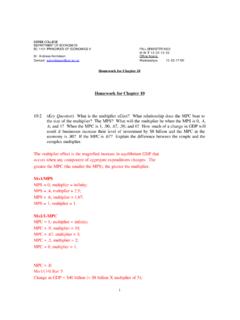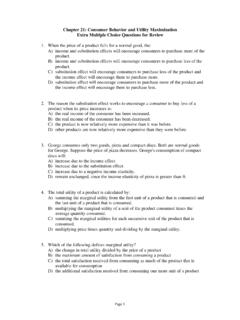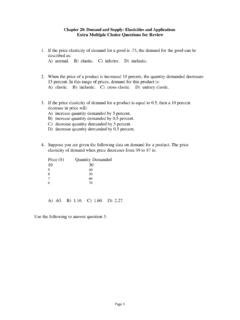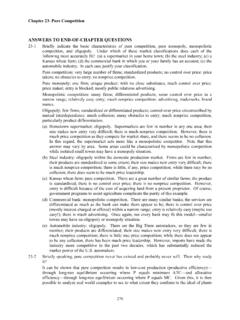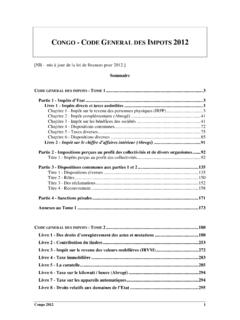Transcription of Study Questions for Chapter 9 - UCL
1 DEREE COLLEGE DEPARTMENT OF ECONOMICS EC 1101 PRINCIPLES OF ECONOMICS II FALL SEMESTER 2002 M-W-F 13:00-13:50 Dr. Andreas Kontoleon Office hours: Contact: Wednesdays 15:00-17:00 Study Questions for Chapter 9 (Answer Sheet) 9-1 Explain what relationships are shown by (a) the consumption schedule, (b) the saving schedule, (c) the investment-demand curve, and (d) the investment schedule. (a) The consumption schedule or curve shows how much households plan to consume at various levels of disposable income at a specific point in time, assuming there is no change in the nonincome determinants of consumption, namely, wealth, the price level, expectations, indebtedness, and taxes.
2 A change in disposable income causes movement along a given consumption curve. A change in a nonincome determinant causes the entire schedule or curve to shift. (b) The saving schedule or curve shows how much households plan to save at various levels of disposable income at a specific point in time, assuming there is no change in the nonincome determinants of saving, namely, wealth, the price level, expectations, indebtedness, and taxes. A change in disposable income causes movement along a given saving curve. A change in a nonincome determinant causes the entire schedule or curve to shift. (c) The investment-demand curve shows how much will be invested at all possible interest rates, given the expected rate of net profit from the proposed investments, assuming there is no change in the noninterest-rate determinants of investment, namely, acquisition, maintenance, operating costs, business taxes, technological change, the stock of capital goods on hand, and expectations.
3 A change in any of these will affect the expected rate of net profit and shift the curve. A change in the interest rate will cause movement along a given curve. (d) The investment schedule shows how much businesses plan to invest at each of the possible levels of output or income. 9-2 Precisely how are the APC and the MPC different? Why must the sum of the MPC and the MPS equal 1? What are the basic determinants of the consumption and saving schedules? Of your own level of consumption? APC is an average whereby total spending on consumption (C) is compared to total income (Y): APC = C/Y. MPC refers to changes in spending and income at the margin.
4 Here we compare a change in consumer spending to a change in income: MPC = change in C / change in Y. When your income changes there are only two possible options regarding what to do with it: You either spend it or you save it. MPC is the fraction of the change in income spent; therefore, the fraction not spent must be saved and this is the MPS. The change in the dollars spent or saved will appear in the numerator and together they must add to the total change in income. Since the denominator is the total change in income, the sum of the MPC and MPS is one. The basic determinants of the consumption and saving schedules are the levels of income and output.
5 Once the schedules are set, the determinants of where the schedules are located would be the amount of household wealth (the more wealth, the more is spent at each income level); expectations of future income, prices and product availability; the relative size of consumer debt; and the amount of taxation. Chances are that most of us would answer that our income is the basic determinant of our levels of spending and saving, but a few may have low incomes, but with large family wealth that determines the level of spending. Likewise, other factors may enter into the pattern, as listed in the preceding paragraph. Answers will vary depending on the student s situation.
6 9-3 Explain how each of the following will affect the consumption and saving schedules or the investment schedule: a. A large increase in the value of real estate, including private houses. b. The threat of limited, non-nuclear war, leading the public to expect future shortages of consumer durables. c. A decline in the real interest rate. d. A sharp, sustained decline in stock prices. e. An increase in the rate of population growth. f. The development of a cheaper method of manufacturing computer chips. g. A sizable increase in the retirement age for collecting social security benefits. h. The expectation that mild inflation will persist in the next decade.
7 I. An increase in the Federal personal income tax. (a) If this simply means households have become more wealthy, then consumption will increase at each income level. The consumption schedule should shift upward and the saving schedule shift leftward. The investment schedule may shift rightward if owners of existing homes sell them and invest in construction of new homes more than previously. (b) This threat will lead people to stock up; the consumption schedule will shift up and the saving schedule down. If this puts pressure on the consumer goods industry, the investment schedule will shift up. The investment schedule may shift up again later because of increased military procurement orders.
8 (c) The decline in the real interest rate will increase interest-sensitive consumer spending; the consumption schedule will shift up and the saving schedule down. Investors will increase investment as they move down the investment-demand curve; the investment schedule will shift upward. (d) Though this did not happen after October 19, 1987, a sharp decline in stock prices can normally be expected to decrease consumer spending because of the decrease in wealth; the consumption schedule shifts down and the saving schedule upwards. Because of the depressed share prices and the number of speculators forced out of the market, it will be harder to float new issues on the stock market.
9 Therefore, the investment schedule will shift downward. (e) The increase in the rate of population growth will, over time, increase the rate of income growth. In itself this will not shift any of the schedules but will lead to movement upward to the right along the upward sloping investment schedule. (f) This innovation will in itself shift the investment schedule upward. Also, as the innovation starts to lower the costs of producing everything using these chips, prices will decrease leading to increased quantities demanded. This, again, could shift the investment schedule upward. (g) The postponement of benefits may cause households to save more if they planned to retire before they qualify for benefits; the saving schedule will shift upward, the consumption schedule downward.
10 This impact is uncertain, however, if people continue to work and earn productive incomes. (h) If this is a new expectation, the consumption schedule will shift upwards and the saving schedule downwards until people have stocked up enough. After about a year, if the mild inflation is not increasing, the household schedules will revert to where they were before. (i) Because this reduces disposable income, consumption will decline in proportion to the marginal propensity to consume. Consumption will be less at each level of real output, and so the curve shifts down. The saving schedule will also fall because the disposable income has decreased at each level of output, so less would be saved.
